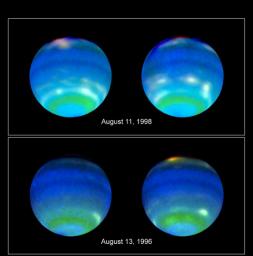Neptune’s Stormy Disposition
Caption:
Using powerful ground-and space-based telescopes, scientists have obtained a moving look at some of the wildest, weirdest weather in the solar system.
Combining simultaneous observations of Neptune made with the Hubble Space Telescope and NASA's Infrared Telescope Facility on Mauna Kea, Hawaii, a team of scientists led by Lawrence A. Sromovsky of the University of Wisconsin-Madison has captured the most insightful images to date of a planet whose blustery weather -- monster storms and equatorial winds of 900 miles per hour -- bewilders scientists.
Blending a series of Hubble images, Sromovsky's team constructed a time-lapse rotation movie of Neptune, permitting scientists to watch the ebb and flow of the distant planet's weather. And while the observations, presented here at a meeting of the American Astronomical Society's Division of Planetary Science, are helping scientists tease out clues to the planet's stormy weather, they also are deepening some of Neptune's mysteries, said Sromovsky.
The weather on Neptune, the eighth planet from the sun, is an enigma to begin with. The mechanism that drives its near-supersonic winds and giant storms has yet to be discerned.
On Earth, weather is driven by energy from the sun as it heats the atmosphere and oceans. On Neptune, the sun is 900 times dimmer and scientists have yet to understand how Neptune's weather-generating machinery can be so efficient.
"It's an efficient weather machine compared to Earth," said Sromovsky. "It seems to run on almost no energy."
In an effort to dissect the distant planet's atmosphere and monitor its bizarre weather, Sromovsky and his colleagues obtained a series of measurements and images over the span of three of Neptune's rotations.
From those observations, Sromovsky said it is possible to measure Neptune's circulation and view a "strange menagerie of variable, discrete cloud features and zonal bands" of weather. Moreover, the new observations enabled Sromovsky's team to probe some of the deeper features of the atmosphere and to map Neptune's cloud tops.
"We can show some clouds are higher than others, that altitudes vary," he said. Knowing something about the topography of Neptune's clouds, provides a direct way to measure Neptune's powerful winds.
A looming mystery, he said, is the fate of huge dark spots, possibly giant storms. When the planetary probe Voyager visited Neptune in 1989, it detected the Great Dark Spot, a pulsating feature nearly the size of the Earth itself. Two years ago, Hubble observations showed the spot had disappeared, and that another, smaller spot had emerged. But instead of growing to a large-scale storm like the Great Dark Spot, the new spot appears to be trapped at a fixed latitude and may be declining in intensity, said Sromovsky, a senior scientist at UW-Madison's Space Science and Engineering Center.
"They behave like storms, and the Great Dark Spot was an exaggerated features we haven't seen on any other planet. They seem to come and go, and rather than an exciting development of these dark spots, they dissipate."
Another strange aspect of the distant planet's weather are distinct bands of weather that run parallel to the Neptunian equator. The weather bands encircle the planet and, in some respects, may be similar to the equatorial region of the Earth where tropical heat provides abundant energy to make clouds.
"We can see regions of latitude where Neptune consistently generates bright clouds," said Sromovsky. The regions are both above and below the planet's equator, but he added that it was uncertain what their explanation is in terms of atmospheric circulation.
Sromovsky said that compared to the look provided by the Voyager spacecraft, Neptune is a different place: "The character of Neptune is different from what it was at the time of Voyager. The planet seems stable, yet different."
Sromovsky's Hubble observations were made with Wide Field Planetary Camera 2 and the Near Infrared Camera and Multi-Object Spectrometer. The different instruments allowed observations to be made in a variety of wavelengths, each providing a different set of information about Neptune's clouds, their structures and how they circulate.
Cataloging Keywords:
| Name |
Value |
Additional Values |
| Target |
Neptune |
|
| System |
Neptune |
|
| Target Type |
Planet |
|
| Mission |
Hubble Space Telescope (HST) |
Voyager |
| Instrument Host |
Hubble Space Telescope |
|
| Host Type |
Space Telescope |
Flyby Spacecraft |
| Instrument |
Wide Field/Planetary Camera 2 (WFPC2) |
|
| Detector |
|
|
| Extra Keywords |
Atmosphere, Color, Infrared, Map, Rotation, Storm, Visual |
| Acquisition Date |
|
| Release Date |
1999-05-21 |
| Date in Caption |
|
|
| Image Credit |
NASA/JPL/STScI |
| Source |
photojournal.jpl.nasa.gov/catalog/PIA01542 |
| Identifier |
PIA01542 |

 Planetary Data System
Planetary Data System
